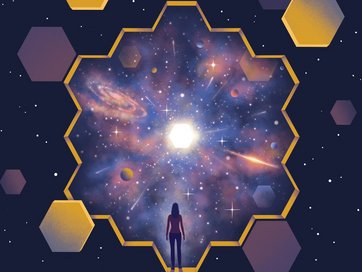If you send a beam of light through a prism, it splits into its spectral colours: red, orange, yellow, green, blue, indigo and violet. We see a rainbow. As light is an electromagnetic wave, each rainbow colour corresponds to a specific wavelength. In the spectroscopic analysis of starlight, the different wavelengths of light are analyzed individually. This technique can shed light on the chemical composition, temperature, size, age and even the fate of a star. This has been known since the end of the 19th century.
But what do you do if you don't have the light of a single star in front of you but the combined light of billions of stars in a distant galaxy? How can astronomers see starlight that is swallowed by thick galactic dust clouds? And how do they distinguish the shimmer of a star from a glowing cloud of hydrogen gas at gigantic distances?
In this Kosmisches Kino, Eva Sextl from the Ludwig-Maximilians-Universität Munich (LMU) takes you on a journey to the stars in distant galaxies. Although these are inaccessible to humanity, modern telescopes and new analysis methods allow us to uncover many well-kept secrets of our neighbouring galaxies.
This event takes place in German.
When: 10.10.2024
Where: Planetarium der ESO Supernova in Garching
Ticket: € 6.50
Reservation: ESO Supernova


